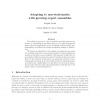51 search results - page 5 / 11 » Sequential sparsification for change detection |
CORR
2011
Springer
13 years 2 months ago
2011
Springer
Forecasting sequences by expert ensembles generally assumes stationary or near-stationary processes; however, in complex systems and many real-world applications, we are frequentl...
BMCBI
2007
13 years 7 months ago
2007
Background: Identification of protein interacting sites is an important task in computational molecular biology. As more and more protein sequences are deposited without available...
ICIAP
2007
ACM
14 years 7 months ago
2007
ACM
Object detection in video surveillance is typically done through background subtraction or temporal differencing. While these techniques perform very well under scenes where there...
INFOCOM
2002
IEEE
14 years 12 days ago
2002
IEEE
Abstract—We propose a simple and robust mechanism for detecting SYN flooding attacks. Instead of monitoring the ongoing traffic at the front end (like firewall or proxy) or a ...
BMCBI
2004
13 years 7 months ago
2004
Background: Multiple sequence alignment algorithms are very important tools in molecular biology today. Accurate alignment of proteins is central to several areas such as homology...

